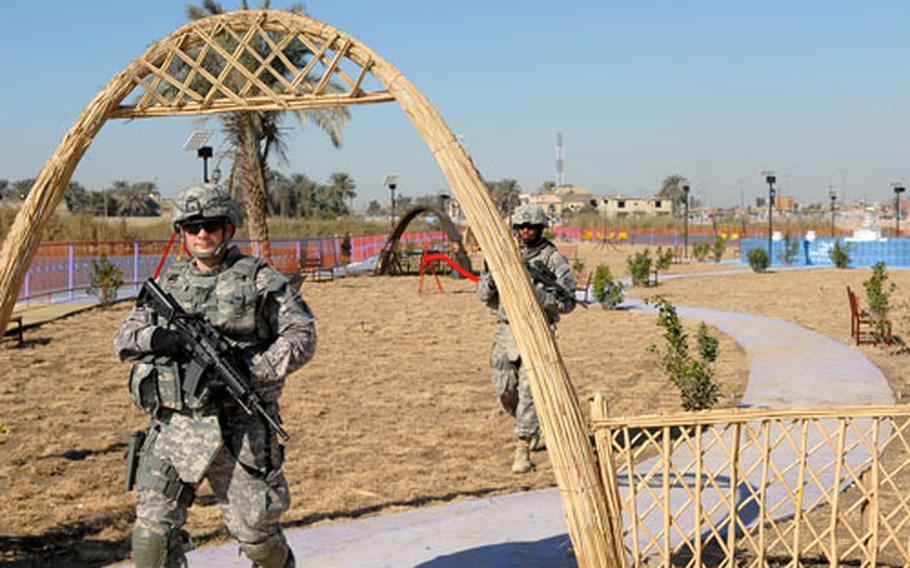
Capt. Philip O’Brien (front) and Sgt. Curtis Calhoun walk under an arch Wednesday at Wishbone Park in Baghdad’s Sadr City district. The peninsula that the parks sits on was once overgrown with weeds, allowing hidden enemy fighters to spy on a nearby joint security station. By building the park, U.S. forces took away the spot from insurgents, a tactic dubbed “non-lethal terrain denial.” (James Warden / Stars and Stripes)
BAGHDAD — There is a field not far from Ali Jassim Jabour’s house in Baghdad’s Sadr City district where the 10-year-old could once watch enemy fighters fire rockets and mortars at the Green Zone.
Ali wasn’t allowed to play on the field. But today the area isn’t the trash-strewn space it once was. U.S. leaders directed efforts to turn the field into a park not long after last spring’s fighting, and a full-size soccer field will soon cover the remainder of the area.
Now that it’s safe, Ali visits the area every day.
Al-Faoo Park, as the new recreation spot is called, is part of a military push dubbed “nonlethal terrain denial,” said Col. Jared Olsen, commander of Task Force Gold, the 926th Engineer Brigade’s team working in Sadr City. Armies have long tried to control key pieces of the land, but that usually meant killing any enemy who tried to enter the area. The park and soccer field, on the other hand, make it harder for enemy fighters to use key areas without directly engaging them.
Those efforts have two purposes, Olsen said. The big-picture purpose is no different from the reason that U.S. forces have poured so much money into rebuilding Iraqi infrastructure: “hearts and minds.”
Shakir Daayer Ali, a local contractor who’s overseen many of the projects, described how local projects win people over and give them confidence that their communities are returning to normal.
“About a year ago, it was a bad situation here; it was very bad,” Ali said. “Now all the people, they are happy when they come here. They take their time. They spend their time here.”
Olsen agreed: “If you live in a community that looks battle-damaged and torn-up and hopeless, than you kind of get a sense of hopelessness.”
But the projects also have a clear tactical benefit, he said. Fighters have a harder time using an area to mount attacks when it’s already being used as something else.
Wishbone Park, which sits across a pond from Joint Security Station Comanche, is a clear example. Enemy fighters could once spy on the base from the reeds that covered the area. But it’s much harder to hide behind the swings, fountain and merry-go-rounds that now cover the cleanly mowed peninsula.
In many parts of Iraq, soldiers would have simply burned the reeds. But neighbors are more likely to discourage or report hostile use of the places where their children play. They also have more incentive to protect a park or soccer field than a trash heap. All this can make the terrain off limits to insurgents.
“It’s harder because now you’re screwing up my park in my community,” Olsen said. “It’s not just a vacant lot anymore.”
Nonlethal terrain denial hasn’t supplanted the traditional means of deterring insurgent attacks — sending soldiers to watch over the sites, or launching random indirect fire attacks on the areas.
The field were the park now stands is known in Army parlance as a point of origin, or POO, site. These are wide-open spaces that have historically been used by insurgents as rocket and mortar launch sites. Sadr City units stepped up efforts to watch over these locations starting with President Bush’s visit to Iraq at the end of December.
For much of January, many platoons have had to check on all launch sites in their area during every patrol, a mission called “POO site denial” (which inevitably led to scores of off-color jokes).
Despite the efforts, rocket attacks still occasionally hit the Green Zone.
Still, Olsen is happy with the progress in an area that was once the site of multiple attacks on the Green Zone each day. Walking around the area Wednesday, he noted that something as simple as playground equipment could make a statement to enemy fighters.
“You’re saying to [insurgents] that this is our territory now,” Olsen said.
Task Force Gold projects in Sadr City
Types of Projects
Access: 21 projects, $6.9 million (15.7 percent of money spent)Sewer: 17 projects, $3.1 million (7 percent)Academics: 39 projects, $9.9 million (22.5 percent)Water: 0 projectsElectric: 27 projects, $6.4 million (14.5 percent)Trash: 26 projects, $4.3 million (9.8 percent)Health: 7 projects, $.9 million (2 percent)Normalcy/Security: 48 projects, $10.1 million (23 percent)Economic Development: 6 projects, $2 million (4.5 percent)Life safety: 1 project, $.4 million (.9 percent)Total: 192 projects, $44 million
Funding source
Iraq: 36 projects, $10.7 million (24.4 percent)U.S.: 156 projects, $33.2 million (75.6 percent)
SOURCE: 926th Engineer Brigade’s Task Force GoldNOTE: Numbers rounded to the nearest tenth